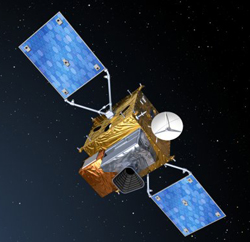- News
31 May 2011
Sofradir’s IR detectors chosen for Sentinel-5-Precursor satellite mission
Sofradir of Châtenay-Malabry, near Paris, France, which makes cooled infrared (IR) detectors based on mercury cadmium telluride (MCT/HgCdTe) for military, space and industrial applications, has been awarded the contract to provide short-wave infrared (SWIR) arrays for the TROPOMI/S5 (Sentinel 5 Precursor) mission, as part of the Global Monitoring for Environment and Security (GMES) space initiative. GMES is a joint undertaking of the European Commission and the European Space Agency (ESA).
 Picture: Sentinel 5 Precursor
Picture: Sentinel 5 Precursor
Sofradir will deliver off-the-shelf 1000x256 SWIR arrays to satellite and space equipment supplier Surrey Satellite Technology Ltd (SSTL) of Guildford, UK, which in January was awarded a €10.69m contract from ESA (via Dutch Space) to provide an SWIR spectrometer as part of the Tropospheric Ozone Monitoring Instrument (TROPOMI) for the Sentinel 5 Precursor atmospheric monitoring mission.
Sofradir says that the selection of an off-the-shelf model that has proven its performance and reliability has eliminated the need for the firm to go through a preliminary design phase, which can involve extensive screening and qualification. This translates into an 18-month saving in delivery time of the flight models. All deliveries will hence be completed within 24 months.
“Repeat orders of our off-the-shelf space-qualified MCT detectors allow us to offer IR products to our space customers at affordable prices with short lead times and minimal risk,” says chairman & CEO Philippe Bensussan.
Scheduled for launch in 2014, the Sentinel-5-Precursor mission is intended to fill a time gap between Envisat (an earlier generation of earth observation satellites for climate and environment monitoring) and Sentinel 5 (which will be on-board the Post-EPS satellite scheduled for launch around 2019).
ESA funded the original development of the 1000x256 SWIR array for the Spectra mission in 1999. Since then, Sofradir has optimized the design of the focal plane array (FPA) and is presently offering two versions of packaging: (i) integrated in a dewar with an active cooler; (ii) in a hermetic package without a cooling system, to be implemented with passive cooling in the satellite.
The SWIR with hermetic package without cooling system was selected because it offered some major advantages in reliability and power consumption, the firm claims. Unlike an active cooler that has moving mechanical parts that can shorten the overall life of the detector, passive cooling significantly increases reliability as it is dependent on the FPA only. Sofradir says that its FPAs are known for their reliability in harsh environments (its IR detectors aboard the spaceborne observation satellite Helios IIA have been operating continuously since its 2004 launch). The fully hermetic package with optimized thermal interface minimizes cooling requirements. Other technological advances have enabled Sofradir to produce SWIR detectors that exhibit very high performance at relatively high temperatures (140K, –133°C), which means that they also consume less power.
Sofradir says that it is increasingly being selected to participate in satellite and space missions for earth mapping, environment and disaster monitoring, meteorology and planet exploration. Its MCT IR detectors are in orbit in French military earth observation satellites Helios IIA and IIB. The firm’s IR detectors are also being used on ESA’s Venus Express satellite (launched in 2005) and the French MoD SPIRALE satellites. All of the detectors are still exhibiting nominal performance. Other space activities include the Japanese space agency (JAXA) SGLI/G-COM (Second Generation GLI/Global Change Observation Mission), where Sofradir’s IR detectors are in Flight Model Phase.
In 2010, Sofradir delivered 26 detectors for space programs. Development teams at Sofradir are also working on a 1000x1000 SWIR array (partially funded by ESA), which has been earmarked as a candidate for several ESA-led projects in the future.
Sofradir HgCdTe MCT SWIR arrays
